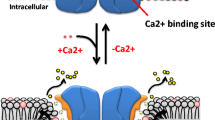Abstract
Cauloside C isolated from Caulophyllum robustum Max. was demonstrated to be a naturally occurring triterpene glycoside having a carboxyl group at C-171,2. This glycoside was characterized as hederagenin 3-O-β-d-glucopyranosyl-(1→2)-α-l-arabinoside (Fig. 1) and it was isolated also from some plants such as Acebia quinata Decne3 and Caltha silvestris Worosc4. Some of these plants have been used as folk medicines, and the glycosides of hederagenin are known to be biologically active substances which have been used as analgesic, diuretic, antiinflammatory agents5,6. It was found that cauloside C showed a high cytotoxicity on sea urchin eggs and embryos7, inhibited macromolecular synthesis, suppressed nucleoside and amino acid transport into the cell, and stimulated the loss of UV-absorbing substance from the cell8,9.
Access this chapter
Tax calculation will be finalised at checkout
Purchases are for personal use only
Preview
Unable to display preview. Download preview PDF.
Similar content being viewed by others
References
L.I. Strigina, N.S. Chetirina, V.V. Isakov, Cauloside C - new triterpene glycoside from Caulophyllum robustum. Identification of cauloside C, Khim. Prirod. Soedin. 5: 619 (1976).
T. Murakami, M. Nagasava, S. Urayama, T. Satake, New triterpenoid saponins in the rhizome and roots of Caulophyllum robustum Maxim. Yakugaku Zasshi. 88: 321 (1968).
R. Higuchi, K. Miyahara, T. Kawasaki, Seed saponins of Akebia quinata Decne. I. Hederagenin 3–0-glycosides, Chem. Pharm. Bull. 20: 1935 (1972).
R. Higuchi, K. Miyahara, T. Kawasaki. Seed saponins of Caltha silvestris Worosc. Hederagenin 3–0-glycosides, Chem.Pharm. Bull. 22: 2294 (1974).
K. Takagi, E.-H. Park, H. Kato, Anti-inflammatory activities of hederagenin and crude saponin isolated from Sapindus mukorossi Gaertn,. Chem. Pharm.Bull. 28: 1183 (1980).
H. Kizu, T. Tomimory, Studies on constituents of Clematis species. I. On the saponins of the root of Clematis chinensis Osbeck, Chem. Pharm. Bull. 27: 2388 (1979).
M.M. Anisimov, E.B. Shentsova, V.V. Shcheglov, L.I. Strigina, N. S. Chetyrina, N.G Aladjina, Toxic effect of certain pentacyclic triterpenoids on early embryogenesis of the sea urchin, Toxicon 14: 259 (1976).
M.M. Anisimov, E.B. Shentsova, V.V. Shcheglov, Y.N. Shumilov, V.A. Rasskazov, L.I. Strigina, N.S. Chetyrina, G.B. Elyakov, Mechanism of cytotoxic action of some triterpene glycosides, Toxicon 16: 207 (1978).
M.M. Anisimov, N.G. Prokofieva, L.I. Strigina, N. S. Chetyrina, N.G. Aladjina, G.B. Elyakov, Cells from rat marrow: sensitivity to effects of certain pentacyclic triterpenoids. Biochem. Pharmacol. 26: 2113 (1977).
P. Mueller, D.O. Rudin, H.T. Tien, N. Wescott, Recent progress in surface science. VI. Academic Press, N.Y. (1984).
T. Malkin, M.R. Shyrbagy, An X-Ray thermal examination of the glycerides.II. The amonoglycerides, J. Chem. Soc. 20: 1628 (1936).
Author information
Authors and Affiliations
Editor information
Editors and Affiliations
Rights and permissions
Copyright information
© 1996 Springer Science+Business Media New York
About this chapter
Cite this chapter
Likhatskaya, G.N. et al. (1996). The pH-Dependent Channels Formed by Cauloside C. In: Waller, G.R., Yamasaki, K. (eds) Saponins Used in Traditional and Modern Medicine. Advances in Experimental Medicine and Biology, vol 404. Springer, Boston, MA. https://doi.org/10.1007/978-1-4899-1367-8_22
Download citation
DOI: https://doi.org/10.1007/978-1-4899-1367-8_22
Publisher Name: Springer, Boston, MA
Print ISBN: 978-1-4899-1369-2
Online ISBN: 978-1-4899-1367-8
eBook Packages: Springer Book Archive




